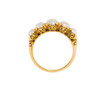This is a late 19th century, graduated pearl ring, also called a half-hoop ring. The setting is hand carved in 18 ct yellow-gold.
The pearls are white in color with a slight silvery hue and still have a nice luster. The gallery is beautifully made, comprised of tiny hand carved Fleur de Lys linked together. It's different from other examples of this period in that is a little larger than most and in that it is finely made, evident in the details.
It makes a great stacking ring or wedding band for those that insist on something unique and with a history. To create a statement stack, consider pairing it with other pearl bands or alternating it with diamonds and other gem-set half-hoops (what we now call "anniversary rings"). We've paired it with two or our modern diamond stacking rings.
Dimensions & Details
- The pearls are thought to be natural rather than cultured due to the date of the ring and due to the fact that they appear to be original to the ring (cultured pearls were not commercially available until the late teens, early 1920's (note: they have not been lab tested).
- The ring is 18 ct gold.
- Ring size is US 6 1/2 or UK M 1/2 and can be easily sized within reason.
Origin
- England.
Period & Hallmarks
- Circa late 19th c.
- Marked/stamped 18 Ct
Condition
- The ring is in good antique condition with general wear that one would expect in a piece of this age.
About 19th Century Rings Trends and Traditions
In some ways the trends of the 19th century are very similar to current trends. Just like we love to "wear rings on every finger" or "stack them" up, so did the Victorians. These two trends have only increased in popularity over the past couple of years. The half-hoop's ring design in particular, lends itself to stacking.
In the 19th c., women often received three different rings when getting married: the engagement ring, the wedding band, and the guard ring (worn with the wedding ring to prevent it from slipping off the finger). Half-hoop pearl rings were a popular choice for "betrothal" or engagement rings throughout most of the 19th c., giving way to diamonds in the last quarter of the century.
If you are interested in reading more about the jewelry terms or decorative periods referenced throughout our site, visit our Resources section for additional information.
Find out how to care for your collection of antique and modern jewels: visit our Jewelry Care page to get advice on maintaining and storing your treasured pieces.
Outside of the U.S.? Please contact us for a shipping quote.
Additional Details
- SKU:
- #RG825










